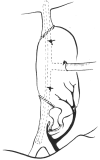Liver transplantation
- PMID: 376970
- PMCID: PMC3215096
- DOI: 10.1016/s0025-7125(16)31684-4
Liver transplantation
Abstract
This assessment of the role of liver transplantation in treating end-stage liver disease today is based on two major series, one from Denver and the other from the Cambridge/Kings College Hospital, England. The findings of these groups are highlighted, as are the changes in technique that have led to considerably improved survival in the past two years.
Figures




References
-
- Bengoechea-Gonzalez E, Awane Y, Reemtsma K. Experimental auxiliary liver transplantation. Arch. Surg. 1967;94:1. - PubMed
-
- Calne RY, Williams R. Liver transplantation. In: Ravitch MM, editor. Current Problems in Surgery. Chicago; Year Book Medical Publ.: 1978.
-
- Cordier G, Gamier H, Clot J-P, et al. La greffe de foie orthotopique chez le pore. Premiers résultats. Mem. Acad. Chir. 1966;92:799. - PubMed
Publication types
MeSH terms
Grants and funding
LinkOut - more resources
Full Text Sources
Miscellaneous

